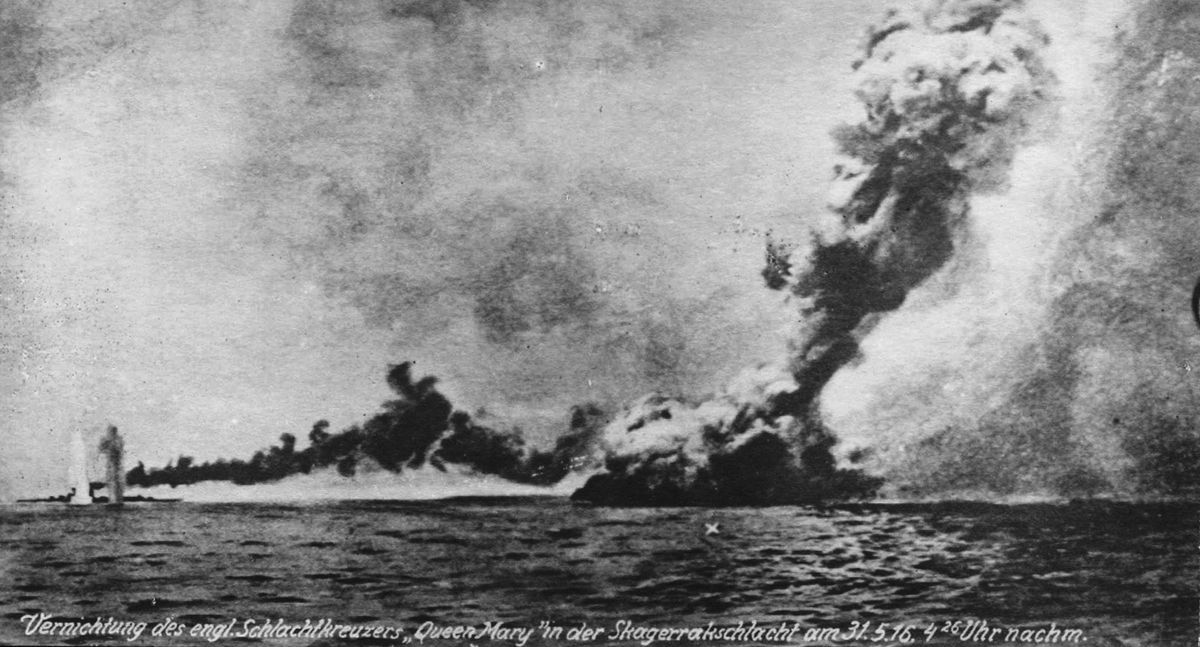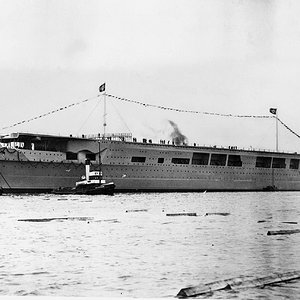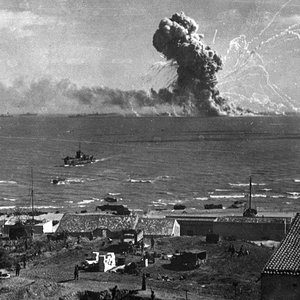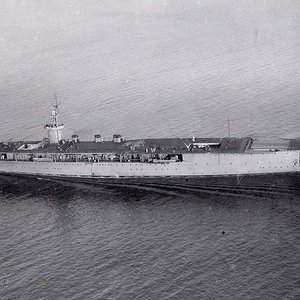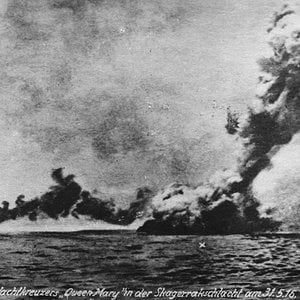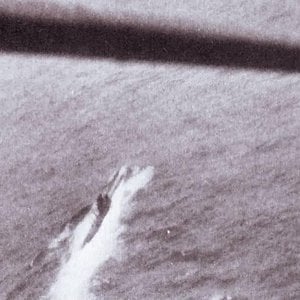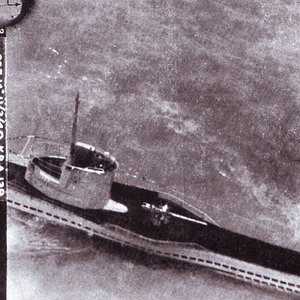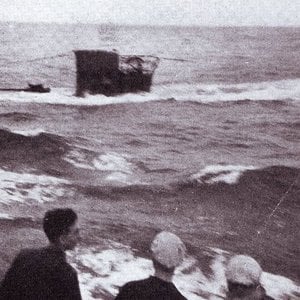Navigation
Install the app
How to install the app on iOS
Follow along with the video below to see how to install our site as a web app on your home screen.
Note: This feature may not be available in some browsers.
More options
You are using an out of date browser. It may not display this or other websites correctly.
You should upgrade or use an alternative browser.
You should upgrade or use an alternative browser.
Tags
Naval Battle
It was just now that the Fifth Battle Squadron reappeared on the scene, finally overtaking both Beatty and Hipper. It was a timely intervention for Beatty: while there was something approaching parity between the lighter German guns versus the thinner British armor and the heavier British guns versus the better-protected German ships, Hipper’s battlecruisers could not stand up to the 15-inch guns of the four Queen Elizabeth class battleships. At 19,000 yards, more than a mile beyond the maximum range of the German guns, Evan-Thomas’s ships opened fire.
The Germans recognized their unmistakable silhouettes and knew what was coming. Georg von Hase, Derfflinger’s gunnery officer, remembered how:
Behind the [British] battlecruiser line appeared four big ships. We soon identified these as the Queen Elizabeth class. There had been much talk in our fleet about this class…. They fired a shell more than twice as heavy as ours. They engaged at portentous ranges.
Endless drills and target practice had produced gunnery in these four dreadnoughts that was among the best in the Grand Fleet. They quickly found the range.
The first German ship to feel the Fifth Battle Squadron’s fire was von der Tann. At 1410 she took a hit aft, the 1,920 pound shell tearing through her armor belt, allowing 600 tons of seawater into her hull. Even the near-misses were punishing, as the explosions shook the ship from stem to stern. All four of the Fifth Battle Squadron’s ships were within range, allowing Barham and Valiant to shift their fire to Moltke, while Warspite and Malaya engaged von der Tann. A shell from one of them punched through Moltke’s side armor and detonated in a starboard coal bunker, setting off a coal dust explosion, which wrecked one of her 5.9-inch guns.
Hipper ordered his ships to begin zigzagging in order to throw off the British gunnery, even though he knew it would affect his own squadron’s shooting. Von der Tann was close to being overwhelmed, as she was the target of not only Warspite and Malaya, but New Zealand as well. At 1617 the British battlecruiser put a shell into the German ship’s forward 11-inch turret, jamming both guns and flooding the magazine. At the same time a 15-inch shell striking aft plunged through von der Tann’s armored deck and knocked out her rear turret. Her remaining two turrets continued to fire, though, scoring a hit on New Zealand in return, although the damage was slight and there were no casualties.
At the head of the two columns, however, one of the most spectacular incidents of the entire battle was about to unfold. Because of faulty British gunnery distribution reminiscent of Dogger Bank, Derfflinger found herself completely unengaged by any of Beatty’s ships. Both she and Seydlitz concentrated her fire on Queen Mary, and before long the accuracy of their shelling extracted an awful toll.
Queen Mary had already been hit several times by this point, with her aft secondary armament wrecked; at least one 11-inch shell had landed near X turret. Observers on Seydlitz saw an ammunition fire flare up in Queen Mary’s after superstructure near the ruined 4-inch battery. Q turret then took a hit that put the right gun out of action, and five minutes after that two shells landed simultaneously on Queen Mary. One hit the left gun of Q turret, breaking it in two, the other seemed to strike somewhere between A and B turrets. According to Midshipman Jocelyn Storey, who was stationed in Q turret,
A heavy shell hit our turret and put the right gun out of action, but killed nobody. Three minutes later an awful explosion took place which smashed up our turret completely. The left gun broke in half and fell into the working chamber and the right one came right back. A cordite fire got going and a lot of the fittings got loose and killed a lot of people.
Petty Officer Ernest Francis, whose battle station was in X turret heard more shells crash into Queen Mary, then there was a sudden, eerie silence; in his words, “Everything in the ship went as quiet as a church.” Francis immediately sensed that something was wrong and, looking out a hatch at the back of X turret, saw that the after superstructure was a shambles and the ship was taking on an ominous list to port. A and B turrets’ magazines had blown up.
Naval Battle
It was just now that the Fifth Battle Squadron reappeared on the scene, finally overtaking both Beatty and Hipper. It was a timely intervention for Beatty: while there was something approaching parity between the lighter German guns versus the thinner British armor and the heavier British guns versus the better-protected German ships, Hipper’s battlecruisers could not stand up to the 15-inch guns of the four Queen Elizabeth class battleships. At 19,000 yards, more than a mile beyond the maximum range of the German guns, Evan-Thomas’s ships opened fire.
The Germans recognized their unmistakable silhouettes and knew what was coming. Georg von Hase, Derfflinger’s gunnery officer, remembered how:
Behind the [British] battlecruiser line appeared four big ships. We soon identified these as the Queen Elizabeth class. There had been much talk in our fleet about this class…. They fired a shell more than twice as heavy as ours. They engaged at portentous ranges.
Endless drills and target practice had produced gunnery in these four dreadnoughts that was among the best in the Grand Fleet. They quickly found the range.
The first German ship to feel the Fifth Battle Squadron’s fire was von der Tann. At 1410 she took a hit aft, the 1,920 pound shell tearing through her armor belt, allowing 600 tons of seawater into her hull. Even the near-misses were punishing, as the explosions shook the ship from stem to stern. All four of the Fifth Battle Squadron’s ships were within range, allowing Barham and Valiant to shift their fire to Moltke, while Warspite and Malaya engaged von der Tann. A shell from one of them punched through Moltke’s side armor and detonated in a starboard coal bunker, setting off a coal dust explosion, which wrecked one of her 5.9-inch guns.
Hipper ordered his ships to begin zigzagging in order to throw off the British gunnery, even though he knew it would affect his own squadron’s shooting. Von der Tann was close to being overwhelmed, as she was the target of not only Warspite and Malaya, but New Zealand as well. At 1617 the British battlecruiser put a shell into the German ship’s forward 11-inch turret, jamming both guns and flooding the magazine. At the same time a 15-inch shell striking aft plunged through von der Tann’s armored deck and knocked out her rear turret. Her remaining two turrets continued to fire, though, scoring a hit on New Zealand in return, although the damage was slight and there were no casualties.
At the head of the two columns, however, one of the most spectacular incidents of the entire battle was about to unfold. Because of faulty British gunnery distribution reminiscent of Dogger Bank, Derfflinger found herself completely unengaged by any of Beatty’s ships. Both she and Seydlitz concentrated her fire on Queen Mary, and before long the accuracy of their shelling extracted an awful toll.
Queen Mary had already been hit several times by this point, with her aft secondary armament wrecked; at least one 11-inch shell had landed near X turret. Observers on Seydlitz saw an ammunition fire flare up in Queen Mary’s after superstructure near the ruined 4-inch battery. Q turret then took a hit that put the right gun out of action, and five minutes after that two shells landed simultaneously on Queen Mary. One hit the left gun of Q turret, breaking it in two, the other seemed to strike somewhere between A and B turrets. According to Midshipman Jocelyn Storey, who was stationed in Q turret,
A heavy shell hit our turret and put the right gun out of action, but killed nobody. Three minutes later an awful explosion took place which smashed up our turret completely. The left gun broke in half and fell into the working chamber and the right one came right back. A cordite fire got going and a lot of the fittings got loose and killed a lot of people.
Petty Officer Ernest Francis, whose battle station was in X turret heard more shells crash into Queen Mary, then there was a sudden, eerie silence; in his words, “Everything in the ship went as quiet as a church.” Francis immediately sensed that something was wrong and, looking out a hatch at the back of X turret, saw that the after superstructure was a shambles and the ship was taking on an ominous list to port. A and B turrets’ magazines had blown up.

